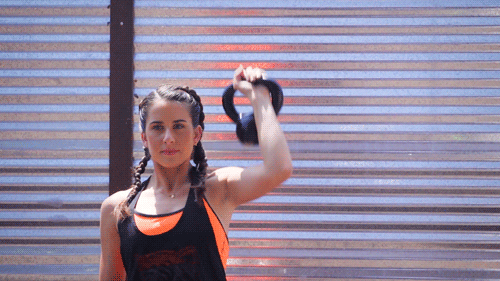What Are the Best Kettlebell Workouts for Beginners?
Last Update: March 29, 2022
I’ve seen kettlebells at the gym, but I have no idea how to use them. How are they different than normal free weights? Are they safe for newbies? I’m worried I’ll drop it mid-swing and break something (my foot, the mirror I’m standing in front of at the gym … the possibilities are endless). Help! —Steve S.
Kettlebells workouts have gained a ton of traction in the past few years because they’re versatile and effective. Do you want a tough cardio session? Grab a kettlebell. How about more strength training? Kettlebells can do that. And those quick HIIT workouts that are so popular these days? Kettlebell workouts were made for high-intensity interval training.
You can do classic dumbbell moves—like bicep curls and tricep extensions—with them, but they’re really designed for dynamic full-body movements.
To get started, you’ll first want to master the basic swing, which involves thrusting the weight forward with an explosive hip movement. It takes some practice to get it down, so I recommend asking a professional trainer at your local gym to show you the perfect technique and correct your form. Here’s how it works:
- Choose a weight that’s not too light, but not too heavy. That’s right, you’re channelling Goldilocks here—to find a weight that’s “just right,” test by lifting with one hand. You want to be able to press the weight above your head with control, but still feel a little resistance. Build up to a heavier weight as your technique improves.
- Stand with a neutral spine. Don’t tuck your tailbone under or hunch your shoulders forward. When you look at yourself sideways in the mirror, your spine should follow a gentle S curve.
- Step your feet shoulder-width apart. Press your bodyweight firmly into your heels, and spread your toes wide in your shoes. Plant the kettlebell on the floor below you between your heels, with your toes slightly turned out.
- Pull your hips back behind you, letting them lead your body into a high-squat position. Maintain a neutral spine and keep your head and chest high. Get low enough to grab the kettlebell with both hands.
- Press down through your feet to stand up and squeeze your glutes to snap your hips forward. Tighten your abs as you do this to protect your back. Remember, you’re using the power in your legs and glutes to move the weight forward, not your arm muscles. The entire action should push your arms up to shoulder level.
The trickiest thing about this movement is the forward hip thrust—don’t be shy! It’ll look a little funny and exaggerated, but it’s that “thrust” action that really helps strengthen your core and legs.
You’ll notice major differences in your body when you start using the kettlebell regularly. Weight training burns fat and creates lean muscle more efficiently than cardio, and because the power behind a lot of kettlebell movements comes from the legs and glutes, you’ll start to see changes in your lower body as well.
Once you get used to the basic swing, move on to this four-move circuit that challenges multiple muscle groups. Try doing each exercise for one full minute, with a 15-second pause as you transition to the next movement. Do the whole circuit once, and gradually build up to repeating it four times through for a seriously sweaty workout that’ll get your heart pumping. And that, my friends, makes it a cardio workout, too!
Kettlebell Swing
Following the guidelines above, keep your shoulders rolled back and down to maintain the best posture, with a firm grip on the kettlebell.
Goblet Squat
Hold the kettlebell directly in front of your sternum with both hands, elbows tucked in to the sides. Squat as low as you can, with control, and return to standing by squeezing your glutes.
Strict Press
Start with the weight in a racked position at the shoulder—hold your hand palm-side up (imagine you’re a waiter holding a platter) with your hand through the handle of the weight. Press the weight in one fluid motion straight up above your shoulder, lowering it down to the starting position with control. Switch to the other arm after one minute.
Lunge Pass
Start with both feet together and holding the weight in your right hand, down by your side. As your right foot steps back into a lunge, pass the weight under your left thigh into your left hand. Return to standing. When the left foot steps back, transfer the weight from the left hand to your right hand by passing under your leg.



